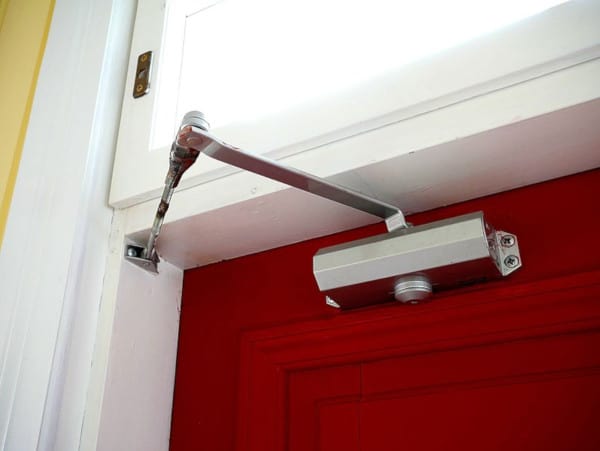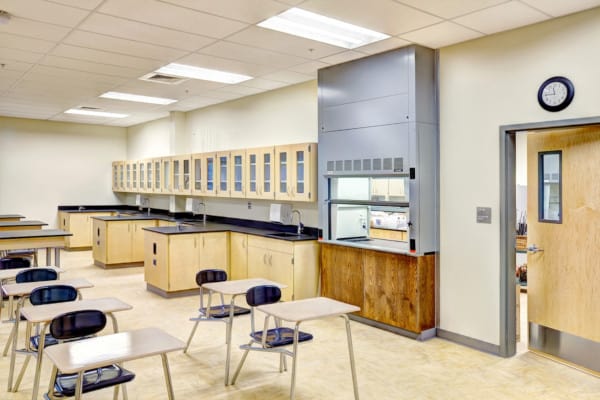Manufacturers, first responders, and code experts offer different—and sometimes incompatible—approaches to school shooting prevention
Every American community has procedures designed to protect schoolchildren against natural disasters, fires, and violence. But growing concern about school shootings is presenting new challenges for decades-old laws and life safety practices.
In this article, we look at how today’s life safety codes tackle the issue of school shooting prevention. We explain why many building codes prohibit the use of barriers, how fire alarms can be protected against malicious use, and how new codes are being developed to streamline responses to an active shooter.
Door barriers designed for school shooting prevention challenge existing building codes
Most American teenagers—and their parents—fear a shooting at their school. That’s according to a Pew Research Study conducted shortly after the 2018 tragedy at Marjory Stoneman Douglas High School in Parkland, FL, which found that nearly 3 in 5 teenagers and their parents were either “very worried” or “somewhat worried” about the possibility.
But parents pressing for school security upgrades have sometimes found themselves at odds with fire and building code officials. In Pataskala, Ohio, parents raised nearly $30,000 to purchase 300 door-security barricades for the Southwest Licking school district. Those devices include bar-style barricades designed to hook over the handle of an outward-swinging door, as shown in the video below:
State and local building code authorities objected, saying that those devices violated Ohio’s building code. After public hearings with code officials, educators, parents, and manufacturers, the Ohio Board of Building Standards issued a 20-page report affirming that barricade devices ran afoul of provisions in the Americans with Disabilities Act and state building code. They cited a provision governing egress doors—doors providing a means of escape in an evacuation or an emergency—which must be “readily openable from the egress side without the use of [a] key or special knowledge or effort.”
For months, those barricades sat in boxes. But later that year, the Ohio legislature intervened. New legislation required the Board of Building Standards to craft provisions permitting the use of barriers in schools, giving Pataskala parents a path forward.
Fire and safety officials stress that barricades can augment the damage caused by school shootings
Ohio’s Board of Building Standards wasn’t alone in its objections to those barricades. Most fire officials surveyed by the National Association of State Fire Marshals say that their state doesn’t permit the use of barricade devices on classroom doors. And while sales of these devices appear to be growing—along with the multi-billion dollar market for school shooting prevention and security—fire marshals and code experts have expressed serious reservations about their use.
Not all barricades are built in the same way: some attach to the door just above the floor, while others feature a bar that fastens to the door’s frame. Another common type slides over the arms of a mechanical door closer. But for these and other common types of barricades marketed to schools, the concern among fire officials remains the same: they don’t align with provisions designed to help first responders provide assistance—and they may trap students in a dangerous situation.

During the 1999 Columbine High School shooting, two active shooters detonated 30 explosives and planted 46 more. In 2018, police discovered ten explosive devices at the scene of a school shooting in Santa Fe, Texas. In their position statement against classroom barricade devices, the Partner Alliance for Safer Schools (PASS) cited cases like these as a reminder that fire hazards may accompany active shooter events—and that maintaining egress routes is a necessary part of school shooting prevention.
PASS has also raised concerns that barricades may be used against students: active shooters have made use of their own makeshift barricades in at least three incidents. By impeding exits, some argue that schools may inadvertently leave children vulnerable to fires, explosives, and outdoor attacks from active shooters.
Concerns about cost surround the use of code-compliant solutions
Many building codes throughout the United States are modeled after guidelines developed by the National Fire Protection Association. According to NFPA 101: Life Safety Code, the most basic alternative to barricade devices consists of an interconnected lock or latch with a keyhole in the hallway and an easy-to-operate thumbturn in the classroom.
NFPA-compliant doors are secured without the use of a key, tool, or special knowledge or effort. The releasing mechanism must be no higher than 48 inches from the floor and no lower than 34 inches. In some models, the handle on the classroom side automatically releases the latch and deadbolt as shown in the video below:
But for cash-strapped communities and school districts, new door hardware may seem like an unnecessary and unaffordable expense—even for school shooting prevention. Some barricades, however, can be purchased at a third of the cost required to retrofit existing doors with a classroom security lockset.
Yet even in cities and states that reject the NFPA’s provisions for school door hardware, schools may find themselves facing unexpected costs. Barricades still appear to violate federal law—particularly, those sections of the Americans with Disabilities Act that require door hardware to be operable with one hand and within reach of wheelchair users. School districts may also face lawsuits stemming from students who misuse barricades to harm themselves or others behind an unbreachable door.
School shooting prevention also poses challenges for fire alarm pull stations
Provisions surrounding classroom doors aren’t the only part of building code to be challenged in the wake of active shooter events. During the Stoneman Douglas High School shooting, the assailant activated a manual fire alarm box, or pull station, setting off the school’s alarm. As the evacuation began, he began firing at students and teachers who tried to escape.
The event renewed discussion around false alarms and school shootings. Lawmakers in Indiana proposed a bill that would allow schools to wait up to three minutes after an alarm sounds before beginning an evacuation. School districts in Michigan adopted policies allowing students to shelter in place while administrators investigate.
Existing fire code does provide some options for schools concerned about the malicious use of fire alarm pull stations. Some pull stations feature plastic covers that sound a small horn—but not the main alarm—when removed, drawing attention to the person activating the alarm. Integrated fire alarm and surveillance systems can also allow administrators to view camera feeds from the area in which a pull station was activated.
NFPA 101 also allows for the elimination of manual fire alarm boxes in some new schools, provided that interior spaces are protected by approved detection devices or a supervised automatic sprinkler system.
From the 2018 edition of NFPA 101
14.3.4.2.3.1* Manual fire alarm boxes shall be permitted to be eliminated where all of the following conditions apply:
(1) Interior corridors are protected by smoke detectors in accordance with Section 9.6.
(2) Auditoriums, cafeterias, and gymnasiums are protected by heat-detection devices or other approved detection devices.
(3) Shops and laboratories involving dusts or vapors are protected by heat-detection devices or other approved detection devices.
(4) Provision is made at a central point to manually activate the evacuation signal or to evacuate only affected areas.14.3.4.2.3.2* Manual fire alarm boxes shall be permitted to be eliminated where both of the following conditions apply:
(1) The building is protected throughout by an approved, supervised automatic sprinkler system in accordance with Section 9.7.
(2) Provision is made at a central point to manually activate the evacuation signal or to evacuate only affected areas.
NFPA 3000, the active shooter standard, includes standards for life-saving partnerships between police and EMS
NFPA’s guidance on school safety issues is largely found in NFPA 101 and various fire prevention codes. But the organization also has a set of standards that deal more directly with shootings and their aftermath.
In the wake of what was the deadliest mass shooting in American history—the Pulse nightclub shooting in Orlando, Florida—NFPA created a standard specifically treating the threat of active shooters. NFPA 3000: Standard for an Active Shooter/Hostile Event Response (ASHER) Program was developed by representatives from the Department of Homeland Security, police, and firefighters beginning in 2016.
Active shooter events require a coordinated response from firefighters, local police, paramedics, and hospitals. But communication gaps between these organizations can interfere with life-saving efforts. NFPA 3000 helps to define the various roles of first responders when the shooter has not yet been captured or disabled.
These standards guide police and medical personnel in collaborative efforts to provide life-saving care to victims even when hazards remain. This stands in stark contrast to some active shooter policies that require medical personnel to keep clear until the building is fully secure—a process that often takes hours.
A recently-published review of the standard in Fire Engineering suggests that NFPA 3000 doesn’t do one thing that’s badly needed: taking a position on when medical care takes priority. Several different procedures are described, including those that provide victims with only the barest access to medical care until the area is fully secure.
But NFPA 3000 was created more quickly than other volumes of code. It’s one of only two provisional standards released in the NFPA’s 122-year history—an exception made only to address emergencies or other special circumstances—and may well undergo important revisions in future cycles.
Developments in life safety, fire safety, and school shooting prevention will continue
Some NFPA standards quietly balance school shooting prevention with other life safety objectives, while others deal with the ugly subject of active shooter situations head-on. But fire, building, and life safety codes remain an indispensable—if sometimes underappreciated—part of protecting students and teachers from harm.
QRFS is dedicated to staying on top of developments in life and fire safety. Our mission is to keep you informed and provide a source for code-compliant, reliable equipment that protects lives and property.
If you have any questions, call us at +1 (888) 361-6662 or email support@qrfs.com.
This blog was originally posted at blog.qrfs.com. If you found this article informative, visit us at Facebook.com/QuickResponseFireSupply or on Twitter @QuickResponseFS.


